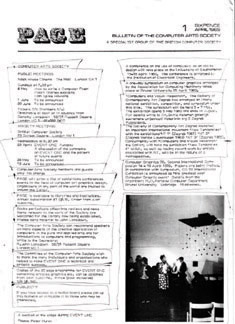PAGE, 1-71 (1969-1985, 2004-2014)
Filed under magazine | Tags: · art history, computer art, computing, history of computing, history of technology, media art, media history, united kingdom

“PAGE is the bulletin of the Computer Arts Society.
The Computer Arts Society was one of the most influential British computer art groups. It was founded in 1968, followed by an inaugural exhibition, Event One, in March 1969 at the RCA. George Mallen, Alan Sutcliffe and Lansdown set up CAS as an offshoot of the British Computer Society, to further the use of computers by artists. CAS flourished through the 1970s and early 80s.
PAGE was initially published from April 1969 until 1985 and was named after the concept of paging (the use of disk memory as a virtual store which had been introduced on the Ferranti Atlas Computer). It featured major British and international computer artists and hosted some fundamental discussions as to the aims and nature of computer art. Its first editor was Gustav Metzger, thereby establishing from the beginning an association with the avant-garde. Metzger was ‘excited’ to discover CAS and ‘people coming together’ as he had ‘felt quite isolated.’ As early as 1961, Metzger had stated that ‘…the artist may collaborate with scientists, engineers.’ As many members were outside of London or overseas, PAGE was an important disseminator of information.”
Publisher Computer Arts Society, London
PDFs (1969-1985 & 2004-2014, updated on 2017-12-2)
PDFs (1969-1985)
Lisa Gitelman, Geoffrey B. Pingree (eds.): New Media, 1740-1915 (2003)
Filed under book | Tags: · history of technology, media, media archeology, media history, new media, phonograph, stereoscope, telephone

Reminding us that all media were once new, this book challenges the notion that to study new media is to study exclusively today’s new media. Examining a variety of media in their historic contexts, it explores those moments of transition when new media were not yet fully defined and their significance was still in flux. Examples range from familiar devices such as the telephone and phonograph to unfamiliar curiosities such as the physiognotrace and the zograscope. Moving beyond the story of technological innovation, the book considers emergent media as sites of ongoing cultural exchange. It considers how habits and structures of communication can frame a collective sense of public and private and how they inform our apprehensions of the “real.” By recovering different (and past) senses of media in transition, New Media, 1740-1915 promises to deepen our historical understanding of all media and thus to sharpen our critical awareness of how they acquire their meaning and power.
Contributors:
Wendy Bellion, Erin C. Blake, Patricia Crain, Ellen Gruber Garvey, Lisa Gitelman, Geoffrey B. Pingree, Gregory Radick, Laura Burd Schiavo, Katherine Stubbs, Diane Zimmerman Umble, Paul Young.
Publisher MIT Press, 2003
Media in Transition series
ISBN 0262072459, 9780262072458
271 pages
Download (removed on 2013-11-12 upon request of the publisher)
Comment (0)David Thorburn, Henry Jenkins (eds.): Rethinking Media Change: The Aesthetics of Transition (2004)
Filed under book | Tags: · cinema, film, hypertext, mass media, media history, museum, phonograph, television

The essays in Rethinking Media Change center on a variety of media forms at moments of disruption and cultural transformation. The editors’ introduction sketches an aesthetics of media transition—patterns of development and social dispersion that operate across eras, media forms, and cultures. The book includes case studies of such earlier media as the book, the phonograph, early cinema, and television. It also examines contemporary digital forms, exploring their promise and strangeness. A final section probes aspects of visual culture in such environments as the evolving museum, movie spectaculars, and “the virtual window.”
The contributors reject apocalyptic scenarios of media revolution, demonstrating instead that media transition is always a mix of tradition and innovation, an accretive process in which emerging and established systems interact, shift, and collude with one another.
Publisher MIT Press, 2004
Media in Transition series
ISBN 0262701073, 9780262701075
416 pages
PDF (updated on 2012-7-15)
Comment (0)
